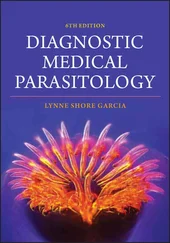Alan Gunn - Parasitology
Здесь есть возможность читать онлайн «Alan Gunn - Parasitology» — ознакомительный отрывок электронной книги совершенно бесплатно, а после прочтения отрывка купить полную версию. В некоторых случаях можно слушать аудио, скачать через торрент в формате fb2 и присутствует краткое содержание. Жанр: unrecognised, на английском языке. Описание произведения, (предисловие) а так же отзывы посетителей доступны на портале библиотеки ЛибКат.
- Название:Parasitology
- Автор:
- Жанр:
- Год:неизвестен
- ISBN:нет данных
- Рейтинг книги:3 / 5. Голосов: 1
-
Избранное:Добавить в избранное
- Отзывы:
-
Ваша оценка:
- 60
- 1
- 2
- 3
- 4
- 5
Parasitology: краткое содержание, описание и аннотация
Предлагаем к чтению аннотацию, описание, краткое содержание или предисловие (зависит от того, что написал сам автор книги «Parasitology»). Если вы не нашли необходимую информацию о книге — напишите в комментариях, мы постараемся отыскать её.
Highly detailed textbook on parasites and parasite relationships Parasitology: An Integrated Approach
Parasitology: An Integrated Approach, 2nd edition
Parasitology — читать онлайн ознакомительный отрывок
Ниже представлен текст книги, разбитый по страницам. Система сохранения места последней прочитанной страницы, позволяет с удобством читать онлайн бесплатно книгу «Parasitology», без необходимости каждый раз заново искать на чём Вы остановились. Поставьте закладку, и сможете в любой момент перейти на страницу, на которой закончили чтение.
Интервал:
Закладка:
Parasitoid: Virus Interactions
Some endoparasitic wasps belonging to the families Ichneumonidae and Braconidae have a fascinating relationship with polydnaviruses. The polydnaviruses from these two wasp families are morphologically distinct, and they probably arose from the ‘domestication’ of two different viruses. However, through convergent evolution they exhibit many biological similarities (Drezen et al. 2017; Strand and Burke 2019).
The viruses replicate within the calyx cells of the wasps’ ovaries and are then secreted into the oviducts. Therefore, when a wasp injects her eggs into a suitable host, usually a lepidopteran caterpillar, she also injects the virus. The viruses cannot replicate within the caterpillar, but they do invade several of its cell types. Within these cells, the viruses integrate into the caterpillar’s genome and cause the expression of substances that facilitate the establishment of the parasitoid. For example, one of the main immune responses that insects express in response to an invader is encapsulation. Encapsulation depends upon recognition of the invader and then a co‐ordinated physiological response: amoeboid‐like cells present in the haemolymph surround the invader and then either kill it through the production of toxic chemicals and/or lack of oxygen or physically isolate it and thereby prevent it damaging the host.
If one implants wasp eggs without the virus into a host, then these are rapidly encapsulated and killed. The protective effect of the virus probably results from it causing the caterpillar to express protein tyrosine phosphatase enzymes and thereby interfering with the encapsulation process. Protein tyrosine phosphatases dephosphorylate the tyrosine residues of several regulatory proteins and are therefore closely involved in the regulation of signal transduction. Altering the levels of regulatory proteins makes it impossible for the host to express an effective immune response and therefore the parasitoid egg develops unmolested. The viruses also have other effects on the caterpillar including preventing its further development once it reaches the stage at which the parasitoid is to emerge. Consequently, the polydnaviruses have a mutualist‐like relationship with the parasitoid within which they replicate. They are transmitted vertically as an endogenous provirus that integrates into the wasp genome but have a pathogenic relationship with the parasitoid’s host, within which it cannot replicate.
It is probable that there are many other examples of symbiotic virus‐parasitoid/parasite relationships awaiting discovery. However, not all wasp parasitoids have relationships with viruses and these inject toxins that cause similar disruptions to the host immune response and host development.
1.2.7 The Concept of Harm
The term ‘harm’ is often employed when describing interactions between organisms but is particularly pertinent to any discussion of host: parasite relationships. Unfortunately, harm is a difficult term to define and is not always easy to measure. For example, parasites are usually much smaller than their host and a single parasite may have such a minor impact that its effect on the physiology and well‐being of the host is too trivial to measure. By contrast, a large number of the same parasite could cause serious illness or even death. Similarly, a low parasite burden may have little impact upon a healthy, well‐nourished adult host, but the same number of parasites infecting an unhealthy, starving young host may prove fatal. Consequently, harbouring a pathogen (being infected) and expressing the signs and symptoms of being infected (suffering from a disease) are not necessarily synonymous. A common analogy is that a single glass of water will not harm you and may even do you good, but the rapid consumption of a thousand glasses of water would kill you. Does that mean that water is beneficial or poisonous? Clearly, it can be both and, likewise, harm is dependent upon the context in which it is being considered. For human parasites, one should also consider the context and psychological consequences. Among some poor communities, being infected by lice and parasitic worms may be considered an unremarkable fact of everyday life. By contrast, in affluent communities, the very thought of harbouring worms inside the body or being bitten by fleas may cause mental torment far above any physical harm caused. It is therefore not a good idea to make the ability to record measurable harm as a pre‐requisite for the classification of the relationship between two organisms. Indeed, in certain instances, low levels of parasitic infection may benefit the well‐being of the host (Maizels 2020). Nevertheless, many parasite species have the capacity to cause morbidity, that is, a diseased state, and some may cause mortality (death). We discuss the possible beneficial consequences of low parasite burdens in more detail in Chapter 12.
The morbidity that parasite infections induce is often reflected in a reduction in the host’s fitness as measured in terms of its growth or reproductive output. This is often attributed to the direct pathogenic effect of the parasite, such as through the loss of blood and the destruction of tissues or competition for resources. For example, many gut helminths act as so‐called kleptoparasites (literally, thieving parasites) and compete with their host for nutrients within the gut lumen. However, the situation is far more complicated than this. Although a functional immune system is crucial for an organism to protect itself against pathogens, immune systems are energetically costly and when nutrients are limiting, it must trade these costs against other physiological processes. Ilmonen et al. (2000) demonstrated this by injecting one group of breeding female pied flycatchers ( Ficedula hypoleuca ) with a diphtheria‐tetanus vaccine and a control group with a saline solution. The vaccine was not pathogenic and did not induce an infection, but it activated the birds’ immune system. They found that birds injected with the vaccine exhibited a lower feeding effort, invested less in self‐maintenance and had a lower reproductive output, as determined by fledgling quality and number. The authors therefore concluded that the energetic consequences of activating the immune system can be sufficient to reduce the host’s breeding success.
1.3 Parasite Hosts
A parasite host is an organism on or in which the parasite lives and from which it derives its nutrition. The host is usually not related taxonomically to the parasite although this is not always the case (see intra‐specific parasites). Most parasites are highly host specific and only infect one host species or a group of closely related species. This is because all hosts represent a unique challenge in terms of the complex adaptations the parasite requires to evolve to identify, invade, and survive within/upon them. Nevertheless, a few parasite species, exploit a wide range of hosts. For example, the protozoan parasite Toxoplasma gondii infects, grows, and asexually reproduces in virtually all warm‐blooded vertebrates although sexual reproduction only takes place within the small intestine of cats.
Hosts can be divided into classes, depending upon the role they play in the parasite’s life cycle. The ‘definitive’ (or final) host is the one in, or on, which the parasite reaches maturity and undergoes sexual reproduction, whilst the ‘intermediate’ host is the one in which the parasite undergoes its developmental stage(s). There may be just one or several intermediate hosts and the parasite may or may not undergo asexual reproduction during this time, but it cannot develop into an adult or reproduce sexually. In this way, some parasites exploit their hosts to maximum effect by combining the reproductive power of asexual reproduction in the larval stage with the advantages of sexual reproduction during the adult stage.
Читать дальшеИнтервал:
Закладка:
Похожие книги на «Parasitology»
Представляем Вашему вниманию похожие книги на «Parasitology» списком для выбора. Мы отобрали схожую по названию и смыслу литературу в надежде предоставить читателям больше вариантов отыскать новые, интересные, ещё непрочитанные произведения.
Обсуждение, отзывы о книге «Parasitology» и просто собственные мнения читателей. Оставьте ваши комментарии, напишите, что Вы думаете о произведении, его смысле или главных героях. Укажите что конкретно понравилось, а что нет, и почему Вы так считаете.












